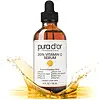What's inside
What's inside
 Key Ingredients
Key Ingredients

 Benefits
Benefits

 Concerns
Concerns

No concerns
 Ingredients Side-by-side
Ingredients Side-by-side

Water
Skin ConditioningTetrahexyldecyl Ascorbate
AntioxidantHelianthus Annuus Seed Oil
EmollientEthylhexyl Isononanoate
EmollientGlycerin
HumectantIsononyl Isononanoate
EmollientSodium Hyaluronate
HumectantSqualene
EmollientButylene Glycol
HumectantPropanediol
SolventMicrococcus Lysate
Skin ConditioningFerulic Acid
AntimicrobialPlankton Extract
Skin ConditioningArabidopsis Thaliana Extract
AntioxidantHordeum Distichon Extract
Skin ProtectingPhellodendron Amurense Bark Extract
Skin ConditioningSantalum Album Extract
CleansingTocopherol
AntioxidantLecithin
EmollientAcrylates/C10-30 Alkyl Acrylate Crosspolymer
Emulsion StabilisingDisodium EDTA
Carbomer
Emulsion StabilisingPhenoxyethanol
PreservativeEthylhexylglycerin
Skin ConditioningSodium Hydroxide
BufferingWater, Tetrahexyldecyl Ascorbate, Helianthus Annuus Seed Oil, Ethylhexyl Isononanoate, Glycerin, Isononyl Isononanoate, Sodium Hyaluronate, Squalene, Butylene Glycol, Propanediol, Micrococcus Lysate, Ferulic Acid, Plankton Extract, Arabidopsis Thaliana Extract, Hordeum Distichon Extract, Phellodendron Amurense Bark Extract, Santalum Album Extract, Tocopherol, Lecithin, Acrylates/C10-30 Alkyl Acrylate Crosspolymer, Disodium EDTA, Carbomer, Phenoxyethanol, Ethylhexylglycerin, Sodium Hydroxide
Aloe Barbadensis Leaf Juice
Skin ConditioningAscorbic Acid
AntioxidantPropanediol
SolventHamamelis Virginiana Bark/Twig Extract
AstringentTremella Fuciformis Sporocarp Extract
AntioxidantBetaine
HumectantGlycerin
HumectantHyaluronic Acid
HumectantFerulic Acid
AntimicrobialDimethyl Sulfone
SolventTocopherol
AntioxidantArgania Spinosa Kernel Oil
EmollientRetinol
Skin ConditioningSimmondsia Chinensis Seed Oil
EmollientPhytic Acid
Sodium Citrate
BufferingSodium Metabisulfite
AntioxidantXanthan Gum
EmulsifyingCaprylyl Glycol
EmollientCaprylhydroxamic Acid
Aloe Barbadensis Leaf Juice, Ascorbic Acid, Propanediol, Hamamelis Virginiana Bark/Twig Extract, Tremella Fuciformis Sporocarp Extract, Betaine, Glycerin, Hyaluronic Acid, Ferulic Acid, Dimethyl Sulfone, Tocopherol, Argania Spinosa Kernel Oil, Retinol, Simmondsia Chinensis Seed Oil, Phytic Acid, Sodium Citrate, Sodium Metabisulfite, Xanthan Gum, Caprylyl Glycol, Caprylhydroxamic Acid
 Reviews
Reviews

Ingredients Explained
These ingredients are found in both products.
Ingredients higher up in an ingredient list are typically present in a larger amount.
Ferulic Acid is a plant based antioxidant. By fighting free-radicals, ferulic acid can help reduce the formation of fine lines and hyperpigmentation.
When used with Vitamin C, Ferulic Acid has shown to prevent Vitamin C from breaking down. In other words, it acts as a stabilizer.
Ferulic Acid is sometimes used to preserve food. Foods containing Ferulic Acid include: oats, rice, eggplant, citrus.
In medicine, Ferulic Acid is being studied for helping with diabetes, Alzheimer's, and cardiovascular diseases.
Learn more about Ferulic AcidGlycerin is already naturally found in your skin. It helps moisturize and protect your skin.
A study from 2016 found glycerin to be more effective as a humectant than AHAs and hyaluronic acid.
As a humectant, it helps the skin stay hydrated by pulling moisture to your skin. The low molecular weight of glycerin allows it to pull moisture into the deeper layers of your skin.
Hydrated skin improves your skin barrier; Your skin barrier helps protect against irritants and bacteria.
Glycerin has also been found to have antimicrobial and antiviral properties. Due to these properties, glycerin is often used in wound and burn treatments.
In cosmetics, glycerin is usually derived from plants such as soybean or palm. However, it can also be sourced from animals, such as tallow or animal fat.
This ingredient is organic, colorless, odorless, and non-toxic.
Glycerin is the name for this ingredient in American English. British English uses Glycerol/Glycerine.
Learn more about GlycerinPropanediol is an all-star ingredient. It softens, hydrates, and smooths the skin.
It’s often used to:
Propanediol is not likely to cause sensitivity and considered safe to use. It is derived from corn or petroleum with a clear color and no scent.
Learn more about PropanediolTocopherol (also known as Vitamin E) is a common antioxidant used to help protect the skin from free-radicals and strengthen the skin barrier. It's also fat soluble - this means our skin is great at absorbing it.
Vitamin E also helps keep your natural skin lipids healthy. Your lipid skin barrier naturally consists of lipids, ceramides, and fatty acids. Vitamin E offers extra protection for your skin’s lipid barrier, keeping your skin healthy and nourished.
Another benefit is a bit of UV protection. Vitamin E helps reduce the damage caused by UVB rays. (It should not replace your sunscreen). Combining it with Vitamin C can decrease sunburned cells and hyperpigmentation after UV exposure.
You might have noticed Vitamin E + C often paired together. This is because it is great at stabilizing Vitamin C. Using the two together helps increase the effectiveness of both ingredients.
There are often claims that Vitamin E can reduce/prevent scarring, but these claims haven't been confirmed by scientific research.
Learn more about Tocopherol